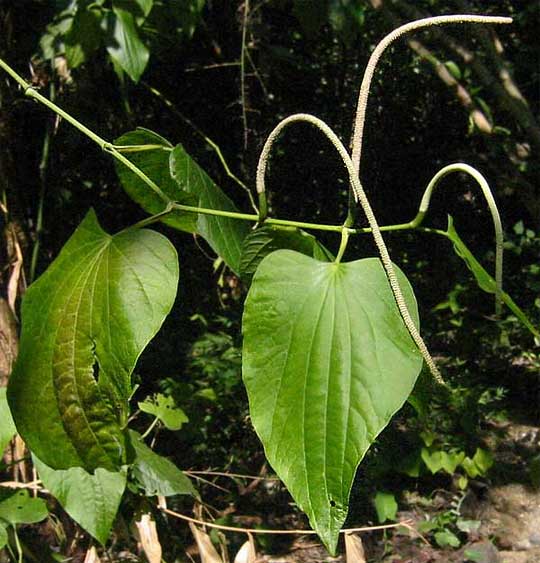Excerpts from Jim Conrad's
Naturalist Newsletter
from the March 17, 2008 Newsletter written in the community of 28 de Junio, in the Central Valley 8 kms west of Pujiltic, elev. ~700m (2300ft), ~N16.331°, ~W92.472°; southeastern Chiapas state, MÉXICO
PIPERS
Another conspicuous and easy-to-identify group of plants in relatively moist habitats here are members of the genus Piper. Pipers are slender bushes or small trees of the Piper Family, in which the popular house-plants known as Peperomias are found. Pipers are easy to recognize because of their slender spikes of very tiny, crammed-together, much-reduced flowers, as demonstrated by our most common Piper, Piper auritum, below:

Piper auritum's crushed leaves emit a pungent, sarsaparilla-like odor. When I worked at the Missouri Botanical Garden in St. Louis back in the 1970s I studied Panamanian Pipers. My work cubical used to be the most fragrant of all at the institution, and no Piper was more spicy-smelling than Piper auritum. Here people often cook their tamales wrapped in Piper auritum's leaves so that the leaves' spicy taste is imparted to the tamales. Piper auritum is often called Hoja Santa here, or "Blessed Leaf."
When Piper auritum's small, greenish spikes of immature flowers first emerge, often they hang down, as in the picture. When flowers in the spikes are mature, the much larger, vividly white spikes are held erect. When the spikes bear maturing fruits, they are once again bent downward. This is another instance of a plant causing its flowers needing to be pollinated to be more attention-getting to visiting pollinators than its immature or already-pollinated flowers.

Above you can see another common species here, PIPER MARGINATA, if my memory serves me. Piper marginata is one of few Piper species with leaves with several pronounced veins radiating from the petiole's point of attachment at the blade's bottom instead of having a single midrib extending up the leaf, with several secondary veins branching off it.
The most famous of all Pipers is Piper nigrum from tropical Asia. That's the plant from which black pepper is made. Peppercorns are dried Piper nigrum fruits. "White pepper" is made from dried Piper nigrum fruits from which the ovary walls have been removed. Our Pipers don't produce fruits big enough to fool with.